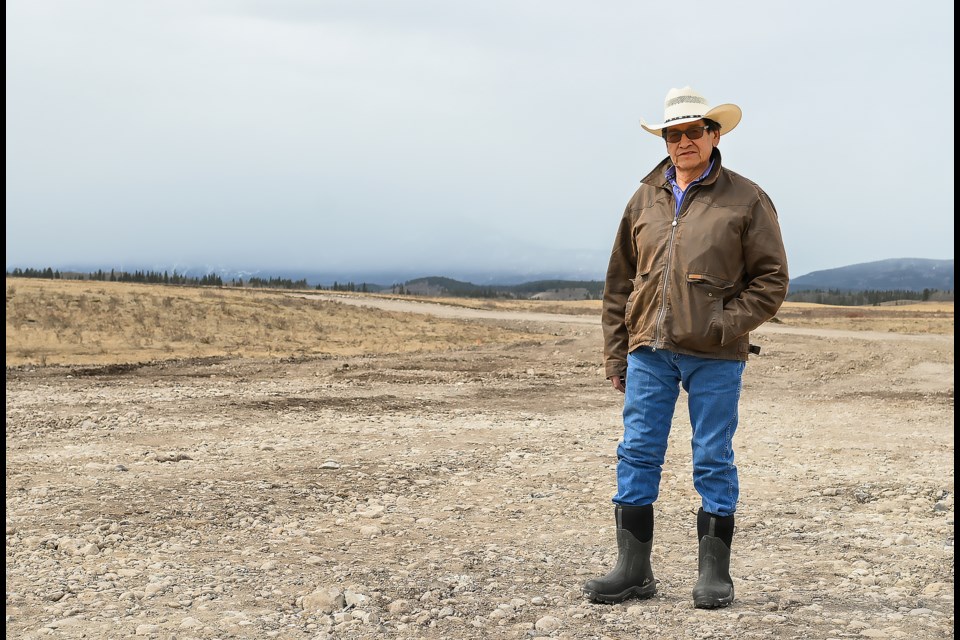ÎYÂRHE NAKODA – Nestled between the foothills and Bow River, and overlooking the Rocky Mountains, one can almost hear the sounds of bounding hooves and cheers as an oval dirt track begins to take shape.
Indian horse relay and rodeo will soon have a home in the Bow Valley in Athâpabi Wapta Îpa Aktakiyebi Châgu Race Track , also known as the Northside Riverbend Race Track, adjacent to the Goodstoney Rodeo Centre off Highway 1A.
“We want to have a racetrack for our young people,” said Goodstoney councillor Watson Kaquitts. “The Stoney tribe have always been good on horses.
“I want to tell boys and girls to come here if they want to be a rider, a catcher, back holder, a jockey, a setter … There’s a role for everyone on the track.”
The roughly $300,000 project is spearheaded by the Goodstoney band’s chief and council. The Nation, which also includes the Chiniki and Bearspaw bands, is using its own natural resources – including gravel, dirt and sand – to lay the 0.8-kilometre track.
A ground-breaking ceremony took place at the site last month with the aim of getting riders on the dirt by the July 1 long weekend. Kaquitts said the plan is to host a two-day rodeo and relay event to celebrate opening the track.
“We want to have a rodeo in the afternoons and then in the evenings, we’ll have relays,” he said. “I think we’ll get a lot of people out from here and elsewhere to watch and participate.
“Many have only seen videos or pictures of Indian relays. It’s very exciting to watch and be part of, and it has a long history.”
A relay team consists of one rider and three additional team members who assist in controlling three fast thoroughbred steeds at the start line.
Riders take one lap with each horse around the track, jumping from one to another as quickly as possible, before the horse they’re riding slows to a stop.
Kaquitts runs the Mînî Thnî Blue Feather Indian relay team, which raced in the event for the first time at the Calgary Stampede last year.
Dubbed by some as America’s first extreme sport, Indian relay did not become popular on rodeo circuits in Canada until about 10 years ago, but it dates back centuries in Indigenous culture.
Kaquitts said there are at least a few teams, including his own, that race out of Îyârhe Nakoda First Nation, but the sport is still growing there.
Riding and racing horses, however, are not novel activities for most Nation members.
“It’s not an official track, but there is a well-known spot out here with a natural, circular patch of trees that our people have long raced horses around,” said Kaquitts, who’s also competed in more than his fair share of Indian National Finals Rodeos.
“Our relationship with horses dates back very far. We used to use them to hunt buffalo, we sing to them – they are a big part of our lives.”
Plans for the racetrack include building a sheltered area for horses, fencing around the track, and spectator stands. It will even have its own natural grandstand, with a nearby hill overlooking the area.
Kaquitts said it was important to choose a location that was not only relatively flat, but near the existing rodeo centre, where they hope to host more events.
Having a good view of the mountains was also part of the criteria.
“The mountains, for us Nakoda people here in Morley … all our stories that our elders tell us, we’re always along the mountains, in the mountains,” he said. “Seeing them from horseback is part of our way of life.”
The Local Journalism Initiative is funded by the Government of Canada. The position covers Îyârhe (Stoney) Nakoda First Nation and Kananaskis Country.




